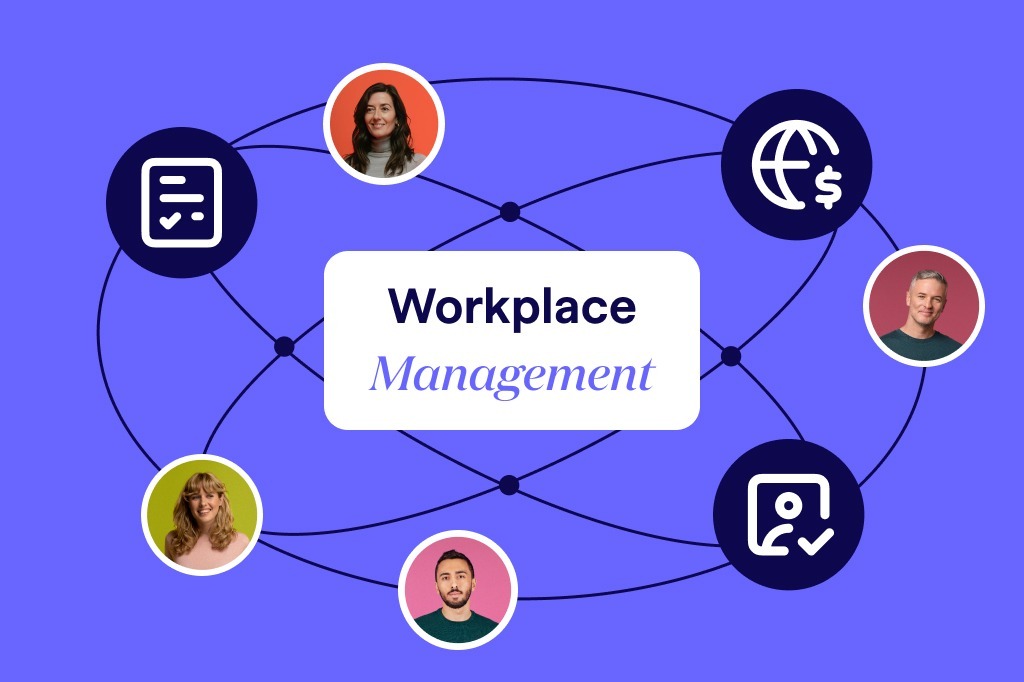Table of Content
Try Vizitor for Free!

Thu, Mar 20, 2025
Read in 7 minutes
Did you know? Companies with strong workplace systems see up to 25% higher productivity. In today’s dynamic work environment, a well-managed workplace is no longer a luxury, it’s a necessity. A quality workplace empowers your team to thrive, fosters collaboration, and ultimately drives business success. But how do you achieve this ideal state? Enter the workplace management system (WMS).

This comprehensive guide dives deep into WMS, exploring its various functionalities and how they contribute to a seamless and productive work experience. We’ll also unveil strategies to craft a winning WMS strategy that propels your organization above the competition.
So, buckle up and get ready to transform your workplace from good to great!
What is Workplace Management System?
A workplace management system (WMS) is like a special tool that helps your office run smoothly and keeps your employees happy. Think of it as a one-stop shop for everything from signing in visitors and booking meeting rooms to figuring out the best way to use your office space and managing deliveries. By taking care of these everyday tasks automatically and making things simpler, a WMS helps create a safe, efficient, and employee-friendly workplace where everyone can work together well, come up with new ideas, and ultimately help the business succeed.

Why is Workplace Management Important?
Statistics speak volumes about the impact of a well-managed workplace:
A Globoforce study reveals that a strong workplace culture can boost productivity by up to 25%.
Steelcase research indicates that satisfied employees are 21% more productive.
These figures paint a clear picture: neglecting workplace management can have a significant negative impact on your bottom line.
A WMS tackles this challenge head-on by streamlining operations across various aspects of your physical workspace. Here’s a breakdown of the key benefits:
Enhanced Security: A WMS bolsters security protocols through features like visitor management systems, access control, and automated ID verification. This safeguards your employees, assets, and intellectual property.
Space Optimization: Inefficient use of space can lead to employee dissatisfaction and hinder productivity. A WMS empowers you to analyze space utilization and implement solutions like hoteling or activity-based working to optimize your layout.
Improved Employee Experience: A WMS fosters a positive employee experience by streamlining processes like meeting room booking, desk reservation, and even delivery management. This empowers employees to focus on core tasks without wasting time on logistical hurdles.
Cost Savings: By optimizing space usage and automating tasks, a WMS can lead to significant cost reductions in areas like rent, utilities, and manpower.
Increased Agility: The modern workplace demands flexibility. A WMS equips you to adapt to changing work styles and business needs through features like hot desking and integrated technology.
Modules of a Workplace Management System
A robust WMS is an ecosystem of interconnected modules, each addressing specific aspects of workplace management. Let’s delve into the key modules that make up a winning WMS:
Attendance Management System: This module automates employee check-in/out processes, tracks working hours, and generates insightful reports for payroll and workforce management.
Meeting Room Management System: Streamline the booking and allocation of meeting rooms, eliminating the hassle of double-bookings and wasted time searching for available spaces.
Space Management System: Gain real-time insights into space utilization, allowing you to optimize your layout for maximum efficiency and employee satisfaction.
Delivery Management System: Simplify and track deliveries within your workplace, ensuring timely receipt of packages and minimizing disruptions.
Visitor Management System: Ensure a smooth and secure visitor experience with pre-registration, digital sign-in, and badge printing functionalities.
Queue Management System: Effectively manage queues in high-traffic areas like reception or service desks, improving customer and employee satisfaction.
By integrating these modules, you create a holistic WMS that orchestrates a seamless and efficient workplace experience.
The Competitive Advantage: Crafting a Winning WMS Strategy
Now that you understand the power of a WMS, here are key steps to craft a winning strategy that sets you apart from the competition:
1. Identify Your Needs: Every organization has unique requirements. Conduct a thorough assessment of your current workplace challenges and employee needs. This will guide your WMS selection process.
2. Embrace Flexibility: The workplace landscape is constantly evolving. Choose a WMS that is adaptable and scalable to accommodate future growth and changing business needs.
3. Prioritize User Experience: Simplicity is key. Opt for a WMS with an intuitive interface that is user-friendly for both employees and visitors.
4. Embrace Data-Driven Decisions: Leverage the power of data analytics provided by your WMS. This will empower you to make informed decisions about space optimization, resource allocation, and overall workplace strategy.
5. Invest in Security: With a growing remote workforce, robust security measures are crucial. Ensure your WMS offers features like access control, visitor management, and secure data storage.
6. Seek Integration: A well-integrated WMS seamlessly connects with existing HR, accounting, and other business systems, eliminating data silos and streamlining workflows.
7. Foster a Culture of Continuous Improvement: Implementing a WMS is an ongoing process. Regularly monitor its effectiveness, gather feedback from employees, and adapt.
Remember, a WMS is not a one-size-fits-all solution. Tailor your strategy to your specific needs and company culture. Regularly solicit feedback from employees to ensure your WMS is meeting their expectations and contributing to a positive work experience.
Before vs. After WMS
| Feature | Before WMS | After WMS |
|---|---|---|
| Visitor Check-In | Manual logbook | Touchless digital entry |
| Meeting Rooms | Double-booked chaos | One-click booking |
| Desk Usage | Overcrowded areas | Hot desking + utilization data |
| Deliveries | Lost or delayed | Tracked and time-stamped |
| Compliance | Paper trails | Audit-ready logs |
| Cost | Inefficient space = high rent | Space optimization = lower costs |
Add a CTA right below:
“Want to experience the ‘After’? Try Vizitor WMS today!”
Frequently Asked Questions (FAQs)
Q1. What is a Workplace Management System (WMS)?
A Workplace Management System (WMS) is a software solution that centralizes and streamlines daily operations in an office or workplace. It includes modules like visitor management, room booking, attendance tracking, and space optimization to create a more efficient, secure, and productive work environment.
Q2. Who needs a WMS?
Any organization with a physical workspace can benefit from a WMS — including corporate offices, hospitals, schools, co-working spaces, and government facilities. Whether you manage 20 employees or 2,000, a WMS can scale to meet your needs.
Q3. What are the core modules of a WMS?
Key modules typically include:
- Visitor Management
- Meeting Room Booking
- Space Utilization Analytics
- Delivery Management
- Attendance Tracking
- Queue Management
These components work together to simplify operations and enhance employee experience.
Q4. How does a WMS improve employee experience?
A WMS reduces friction in everyday tasks like booking desks or checking in guests. This saves employees time and enhances workplace satisfaction by allowing them to focus on their core responsibilities rather than logistics.
Q5. Is a WMS secure?
Yes. Most modern WMS platforms offer enterprise-grade security features, such as:
- Encrypted data storage
- Access control systems
- Audit trails and logs
- Secure visitor and delivery tracking
These measures help protect sensitive information and ensure compliance.
Q6. Can a WMS support hybrid or flexible work models?
Absolutely. WMS systems are built to support hot desking, hoteling, remote coordination, and space usage analysis — making them perfect for today’s evolving workplace models.
Q7. What’s the ROI of implementing a WMS?
A well-implemented WMS can lead to:
- Up to 30% reduction in space-related costs
- 25% boost in employee productivity
- Better decision-making with real-time workplace data
- Enhanced employee engagement and retention
Q8. Does a WMS integrate with other software?
Yes. The best WMS solutions integrate seamlessly with:
- HR systems
- Payroll and attendance software
- Calendar apps (Google, Outlook)
- Access control systems
This avoids data silos and ensures smooth operations.
Q9. How can I choose the right WMS for my organization?
Start by:
- Identifying your workplace challenges
- Prioritizing features (e.g. visitor management, space tracking)
- Evaluating usability and scalability
- Looking for integration options
- Ensuring strong support and data security
Try a few demos or trials — like Vizitor’s Workplace Management System — to see what fits best.
Q10. Can small businesses use a WMS?
Yes! WMS platforms like Vizitor are scalable and user-friendly, making them perfect for small to medium-sized enterprises that want to grow efficiently and professionally.
Conclusion: Investing in Success
A well-implemented workplace management system is not just a software solution, it’s an investment in the future of your organization. By fostering a productive, secure, and employee-centric workplace, a WMS empowers your team to thrive and your business to soar.
Ready to unlock the potential of a well-managed workplace? Carefully consider your needs, explore available WMS solutions, and embark on a journey to transform your space into a competitive advantage.
Remember, a happy and productive workforce is the key to organizational success. Take the first step towards achieving this goal by implementing a WMS that optimizes your workplace for the future.










